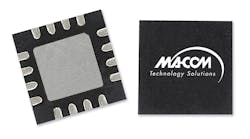Model XX1010-QT is a GaAs monolithic-microwave-integrated-circuit (MMIC) frequency doubler from M/A-COM Technology Solutions that is well suited for satellite-communications (satcom) and point-to-point communications systems. The active frequency doubler integrates a gain stage, doubler, and driver amplifier into a single device. It accepts input signals from 14.625 to 15.000 GHz and delivers output signals from 29.25 to 30.00 GHz. It provides +20-dBm saturated output power with -35-dBc fundamental-frequency suppression. It is supplied in a RoHS-compliant, 16-lead, 3 x 3 mm plastic QFN package. Designed to operate from a single +5-VDC supply (it draws typically 200 mA current), the active doubler includes DC blocking and bypassing capacitors, eliminating the need for any external components.
M/A-COM Technology Solutions, 100 Chelmsford St., Lowell, MA 01851; (978) 656-2500, www.macomtech.com.
